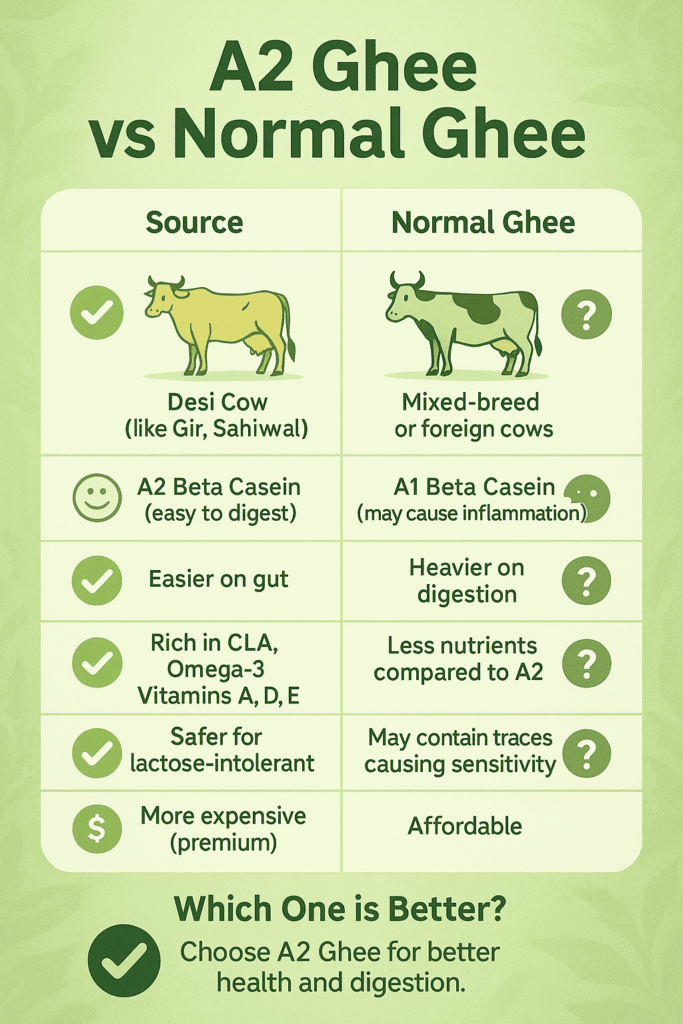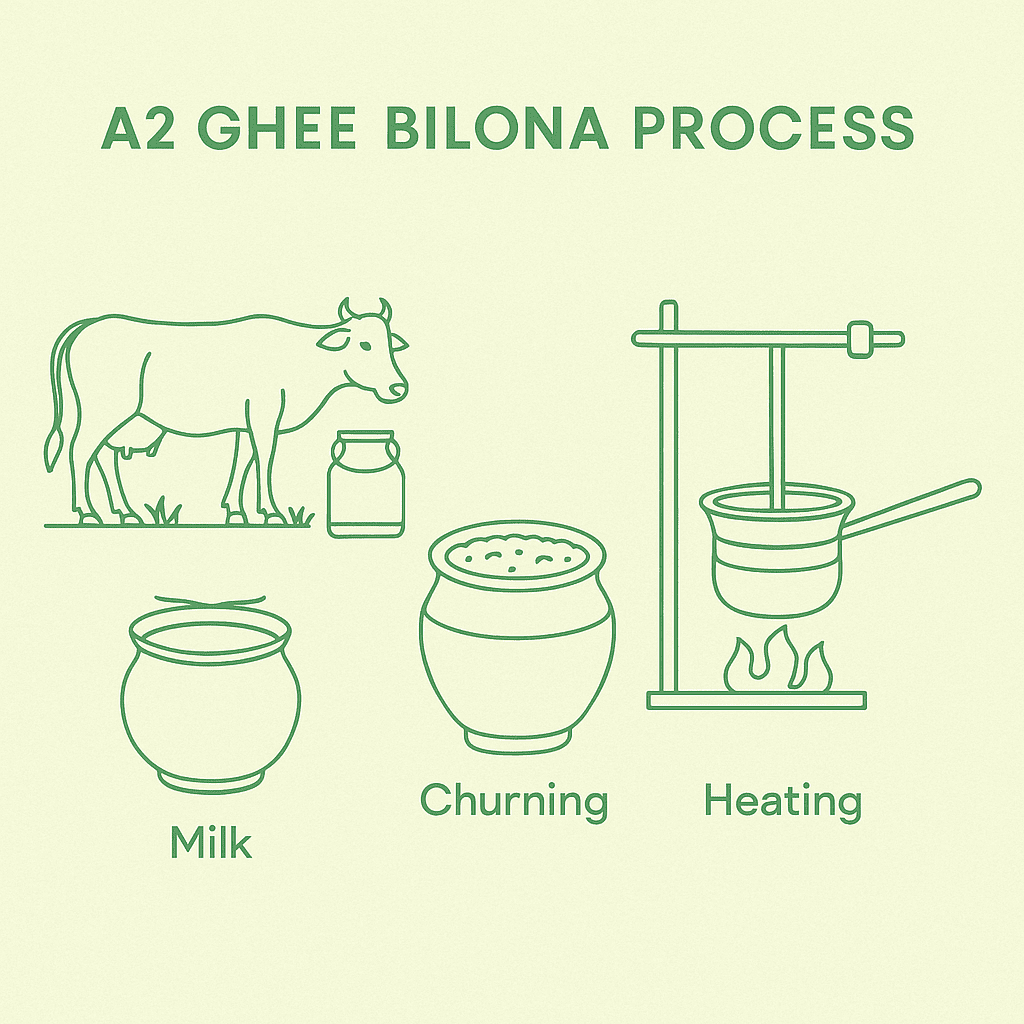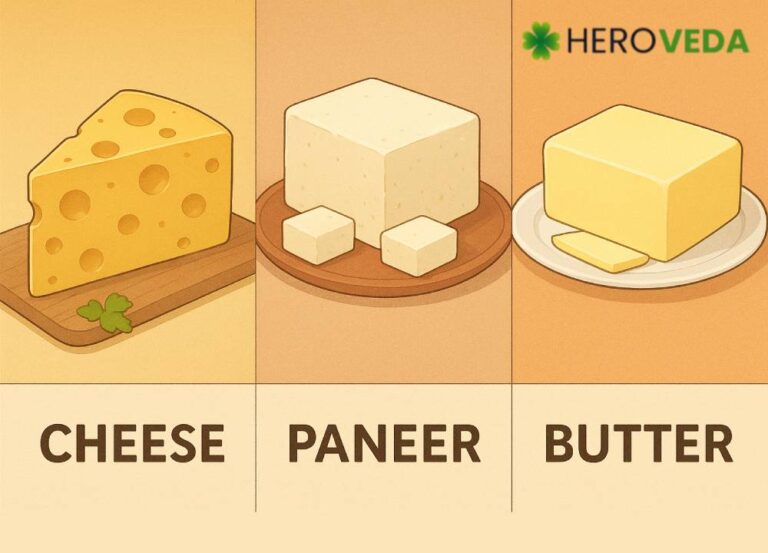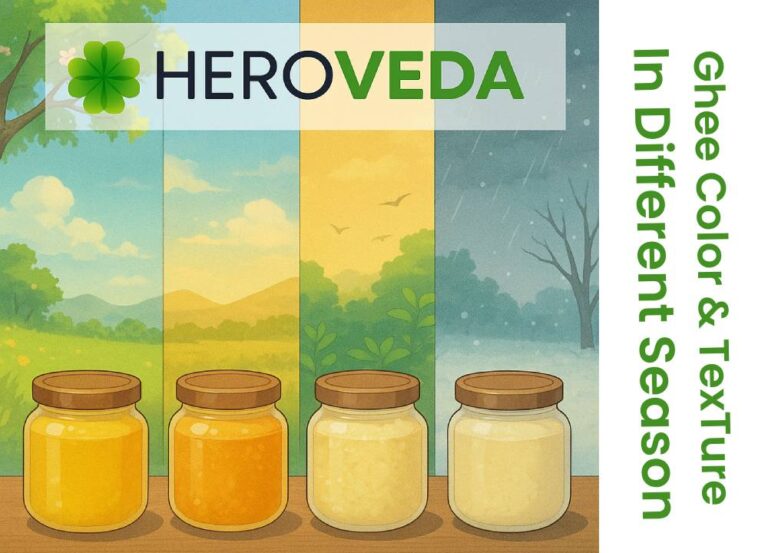Become the Healthiest, Happiest Version of Yourself — Naturally.

A2 Ghee Vs Normal Ghee: Which Is Healthier?
Ghee has been an important ingredient in our kitchen and in Ayurvedic medicine for centuries. But as people get more aware of their health and their environment, a new debate has started about A2 ghee vs normal ghee, which is healthier and better for our body.
Is A2 ghee really superior? Does it provide more health benefits, or is it just another marketing trend?
In this article, I will guide you on this topic, and my guide is backed by experts, so you will understand the differences, benefits, and facts that can help you to make an informed choice.
What Is Ghee?
Ghee is made by gently heating butter, which is first created by churning fresh cream. As the butter simmers, any impurities rise to the top and are carefully removed. What’s left is a golden, clear liquid fat that’s poured off, leaving behind the milk solids at the bottom.
The final taste, color, and texture of ghee can vary quite a bit, depending on the quality of the butter, the type of milk it comes from, and how long it’s cooked.
It is prized for its high smoke point, rich flavor, and versatility in cooking and traditional remedies.
A2 Ghee vs Normal Ghee: Key Differences
| Feature | A2 Ghee | Normal (Regular) Ghee |
|---|---|---|
| Source of Milk | Indigenous (Desi) cows (e.g., Gir, Sahiwal) | Hybrid/crossbred cows (e.g., Holstein, Jersey) |
| Protein Type | Only A2 beta-casein protein | Both A1 and A2 beta-casein proteins |
| Production Method | Traditional Bilona (curd-churning) | Modern, mass-produced (cream/butter method) |
| Digestibility | Easier to digest, gut-friendly | May cause discomfort for some |
| Nutrient Profile | Higher in CLA, vitamins, butyric acid | Good nutrients, but may be less digestible |
| Ayurvedic Value | Considered sattvic, medicinal | Lacks some traditional Ayurvedic benefits |
| Taste & Texture | Rich, nutty, grainy texture | Greasier, less aromatic |
| Price & Availability | More expensive, less widely available | Cheaper, widely available |
| Lactose/Casein | Free from lactose and A1 casein | Free from lactose, contains A1 casein traces |
The Science of A1 vs A2 Proteins

Milk contains two main types of beta-casein proteins: A1 and A2. Indigenous Indian cows produce only the A2 type, while most modern hybrid cows produce both A1 and A2.
Research suggests that A1 beta-casein may be linked to digestive issues and inflammation in some people, while A2 is considered gentler on the gut.
“A2 ghee is traditionally prepared using the Bilona churning method, which retains its nutrients and enhances its medicinal properties.”
How A2 Ghee Is Made: The Bilona Method

A2 ghee made using the bilona method is a traditional way of making pure, healthy ghee from desi cow’s milk. Here’s how it works:
- First, milk from desi cows (which produce A2 milk) is boiled and cooled.
- This milk is then turned into curd (yogurt) by adding a natural starter.
- The curd is churned slowly using a wooden churner—this is called the “bilona” method.
- Churning separates the butter from the buttermilk.
- The butter is collected and gently heated on a low flame, which turns it into golden, aromatic ghee.
This old-fashioned process keeps the nutrients intact and gives the ghee a rich flavor and natural aroma. People prefer A2 bilona ghee because it’s believed to be easier to digest and full of health benefits compared to regular ghee made by industrial methods
Normal Ghee: Modern Production

Most of the ghee you find in stores today is made using modern, large-scale methods. Instead of using the traditional curd-churning process, normal ghee is usually produced from the cream that rises to the top of milk collected from various breeds of cows, especially high-yield or crossbred ones like Holstein or Jersey.
In factories, this cream is separated quickly and then heated at high temperatures to remove water and milk solids. This process is much faster and more efficient for making large quantities of ghee. However, because it’s made in bulk and often at higher temperatures, some of the natural nutrients and the rich, nutty flavor found in traditional ghee can be lost.
Normal ghee is widely available and more affordable, making it a popular choice for everyday cooking. But if you’re looking for the deeper taste and possible health benefits of traditional ghee, you might notice that normal ghee feels a bit less aromatic and flavorful.
A2 Ghee Vs Normal Ghee: Nutritional Comparison
| Nutrient/Component | A2 Ghee | Normal Ghee |
|---|---|---|
| Butyric Acid | Higher, aids digestion, gut health | Present, but may be lower |
| Omega-3 Fatty Acids | Rich source, supports heart health | Present |
| Vitamins A, D, E, K | Abundant, fat-soluble, boosts immunity | Present |
| CLA (Conjugated Linoleic Acid) | High, anti-inflammatory, weight management | Present, lower levels |
| Antioxidants | Higher, fights free radicals | Present |
| Lactose/Casein | Virtually absent, easy for lactose-intolerant | Lactose-free, but contains A1 casein |
A2 Ghee Vs Normal Ghee: Health Benefits
A2 Ghee
- Digestive Health: Rich in butyric acid, A2 ghee nourishes gut lining, aids digestion, and reduces inflammation.
- Immunity: Contains antioxidants and fat-soluble vitamins that boost immunity.
- Heart Health: Omega-3 fatty acids and CLA support cardiovascular health and reduce inflammation.
- Brain & Memory: Multi-chain triglycerides and vitamins support cognitive function.
- Skin & Hair: Nourishes skin and hair, used in Ayurvedic massage and remedies.
- Ayurvedic Value: Considered ‘sattvic’—promotes balance, clarity, and vitality.
Normal Ghee
- Energy Source: High in healthy fats, provides sustained energy.
- Vitamins: Contains essential vitamins and supports bone health and immunity.
- Cooking Benefits: High smoke point, suitable for Indian cooking.
However, normal ghee may not be as easily digestible for those sensitive to A1 protein.
A2 Ghee Vs Normal Ghee: Ayurvedic Perspective
Ayurveda reveres ghee, especially when made from desi cow’s milk, as a sacred food and medicine. It is believed to
- Balance doshas (especially Vata and Pitta)
- Enhance memory and intellect
- Promote longevity and vitality
- Detoxify the body
“Ayurveda considers ghee a ‘sattvic’ food, meaning it promotes balance, clarity, and good health. However, only traditionally prepared A2 ghee retains these qualities.”
Taste, Aroma, and Culinary Experience
- A2 Ghee: Rich, nutty aroma; golden color; grainy (‘danedaar’) texture; sweet aftertaste. Enhances the flavor of traditional recipes.
- Normal Ghee: May be paler, less aromatic, and greasier in texture. Lacks the depth of flavor found in A2 ghee.
Many chefs and home cooks report that dishes made with A2 ghee taste more authentic and nostalgic.
Also Read:
Why Is A2 Ghee More Expensive?
- Low Yield: Desi cows produce less milk (8–12 liters/day) compared to hybrid cows (30+ liters/day).
- Traditional Methods: The labor-intensive Bilona process increases costs.
- Sustainable Practices: Desi cows are often pasture-raised, adding to the expense.
- Limited Supply: Fewer desi cows, higher demand for A2 products.
Common Myths About A2 Ghee
Myth 1: A2 Ghee and Normal Ghee Are the Same
While both are clarified butter, A2 ghee’s unique protein structure and traditional preparation make it superior in digestibility and health benefits.
Myth 2: A2 Ghee Is Just Expensive Butterfat
A2 ghee’s nutritional profile, digestibility, and Ayurvedic value justify its higher price.
Myth 3: There’s No Real Difference
Many people switching to A2 ghee report improved digestion, reduced bloating, and general well-being.
Who Should Choose A2 Ghee?
- People with dairy sensitivities or lactose intolerance
- Those seeking traditional, Ayurvedic foods
- Health-conscious individuals wanting nutrient-dense fats
- Anyone looking to support gut health, immunity, and overall wellness
How to Identify Authentic A2 Ghee
- Source: Look for brands specifying indigenous cow breeds (Gir, Sahiwal, Tharparkar)
- Production: Prefer Bilona or curd-churning method
- Label: Check for “A2” and absence of additives or preservatives
- Texture & Aroma: Grainy, golden, nutty aroma
Conclusion
Both A2 ghee and normal ghee offer health benefits, but A2 ghee stands out for its digestibility, traditional preparation, rich nutrient profile, and deep roots in Ayurveda. If you value authentic taste, gut health, and holistic wellness, A2 ghee is worth the investment1245.
For everyday cooking, normal ghee is still a healthy, versatile fat. However, if you have the option and budget, switching to A2 ghee can be a meaningful upgrade for your health and culinary experience.
FAQs
Is A2 ghee lactose-free?
Yes, both A2 and normal ghee are lactose-free, but A2 ghee is also free from A1 casein, making it gentler on the gut.
Can I use A2 ghee for frying?
Absolutely! Both types have a high smoke point, but A2 ghee’s rich flavor makes it ideal for sautéing, frying, and even baking.
Is A2 ghee suitable for children and the elderly?
Yes, its nutrient density and digestibility make it suitable for all ages, especially those with sensitive digestion.








